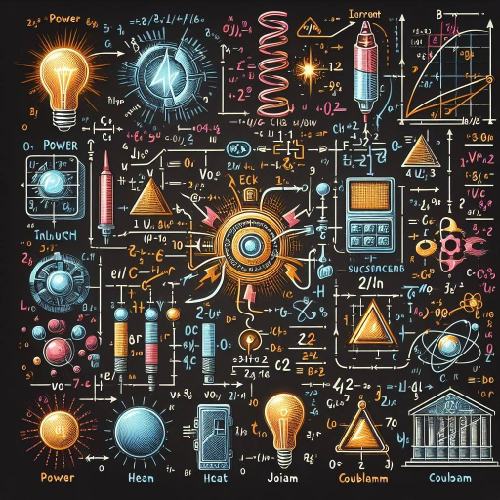In the realm of physics, understanding the fundamental concepts of electricity Resistance, Voltage, Current, Joule and Coulomb. One such concept that plays a crucial role in electrical systems is resistance. Resistance, measured in ohms, impedes the flow of electric current through a conductor. This article delves into the intricate relationship between current, volt, joule and resistance as power. we will unravel the physics behind these interconnected phenomena.
Understanding Volts and Joules:
Before delving into the relationship between volts to joules, and resistance, it’s imperative to grasp the individual concepts. Volts represent electrical potential difference or voltage, symbolized by the letter “V.” In simple terms, volts measure the force that drives electric current through a circuit. On the other hand, joules, denoted by “J,” quantify energy. A joule is equivalent to the work done when a force of one volt moves one coulomb of charge. In essence, volts represent the potential, while joules represent the energy derived from that potential.
The Role of Resistance:
Resistance, denoted by the symbol “R” and measured in ohms (Ω), opposes the flow of electric current in a circuit. This opposition arises due to the collisions between moving electrons and the atoms of the conductor material. The higher the resistance, the more difficult it becomes for electrons to flow, resulting in decreased current flow. Resistance calculator.
Ohm’s Law:
At the heart of understanding the relationship between volts, joules, and resistance lies Ohm’s law. Ohm’s law states that the current passing through a conductor between two points is directly proportional to the voltage across the two points and inversely proportional to the resistance. Mathematically, Ohm’s law is expressed as:
V = IR
Where:
V is the voltage (in volts)
I is the current (in amperes)
R is the resistance (in ohms)
This equation illustrates that the voltage across a conductor is directly proportional to the current passing through it and inversely proportional to the resistance of the conductor.
Relationship Between Current, Volt, Heat, and Resistance:
The relationship between volts, joules, and resistance becomes apparent when considering the energy dissipated in a resistor. When an electric current flows through a resistor, energy is transformed and dissipated in the form of heat. This energy dissipation can be calculated using the formula. Here total heat dissipated over time t is denoted by H. Formula of heat produced by current.
H = I²Rt
H = (V²/R)t
Relation of Joules and Coulombs:
V = J/C
I = Q/t
Calculation of electrical Power,
P = VI = (J/C)*(Q/t)
If we put charge to one coulomb i.e. Q = 1C we have,
P = J/t
From above expression we can say one watt is one joule per second.
Practical Implications:
Understanding the relationship between volts, joules, and resistance has practical implications in various fields, including electronics, engineering, and physics research. Engineers utilize this knowledge when designing circuits to ensure efficient energy transfer and component functionality. By manipulating resistance values, they can control the flow of current and regulate voltage levels within a circuit.
When the current flow through a conductor it carries electrons which are having negative charge. The negatively charged electron during their flow through conducting wire collide with atoms and dissipate their energy in the form of heat.
Moreover, in physics research, this understanding aids in the analysis of electrical systems and the determination of energy consumption. Researchers can quantify the energy dissipated in resistors and use this information to optimize system performance and minimize power losses.
Conclusion:
In conclusion, the relationship between volts to joules conversion lies at the core of understanding electrical phenomena. By comprehending Ohm’s law and the principles of energy dissipation in resistors, we gain insight into the behavior of electrical circuits and systems. This knowledge not only facilitates the design and optimization of electronic devices but also contributes to advancements in various fields reliant on electrical technologies. As we continue to unravel the mysteries of electricity, the interplay between resistance volts, Joule and Coulomb remains a cornerstone of modern physics and engineering.



Thanks for great guide! These fundamental principles are crucial for understanding and designing electrical systems.